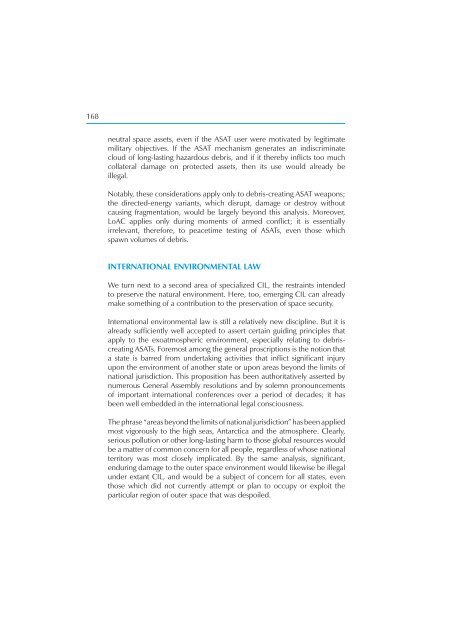Security in Space The Next Generation - UNIDIR
Security in Space The Next Generation - UNIDIR
Security in Space The Next Generation - UNIDIR
You also want an ePaper? Increase the reach of your titles
YUMPU automatically turns print PDFs into web optimized ePapers that Google loves.
168<br />
neutral space assets, even if the ASAT user were motivated by legitimate<br />
military objectives. If the ASAT mechanism generates an <strong>in</strong>discrim<strong>in</strong>ate<br />
cloud of long-last<strong>in</strong>g hazardous debris, and if it thereby <strong>in</strong>fl icts too much<br />
collateral damage on protected assets, then its use would already be<br />
illegal.<br />
Notably, these considerations apply only to debris-creat<strong>in</strong>g ASAT weapons;<br />
the directed-energy variants, which disrupt, damage or destroy without<br />
caus<strong>in</strong>g fragmentation, would be largely beyond this analysis. Moreover,<br />
LoAC applies only dur<strong>in</strong>g moments of armed confl ict; it is essentially<br />
irrelevant, therefore, to peacetime test<strong>in</strong>g of ASATs, even those which<br />
spawn volumes of debris.<br />
INTERNATIONAL ENVIRONMENTAL LAW<br />
We turn next to a second area of specialized CIL, the restra<strong>in</strong>ts <strong>in</strong>tended<br />
to preserve the natural environment. Here, too, emerg<strong>in</strong>g CIL can already<br />
make someth<strong>in</strong>g of a contribution to the preservation of space security.<br />
International environmental law is still a relatively new discipl<strong>in</strong>e. But it is<br />
already suffi ciently well accepted to assert certa<strong>in</strong> guid<strong>in</strong>g pr<strong>in</strong>ciples that<br />
apply to the exoatmospheric environment, especially relat<strong>in</strong>g to debriscreat<strong>in</strong>g<br />
ASATs. Foremost among the general proscriptions is the notion that<br />
a state is barred from undertak<strong>in</strong>g activities that <strong>in</strong>fl ict signifi cant <strong>in</strong>jury<br />
upon the environment of another state or upon areas beyond the limits of<br />
national jurisdiction. This proposition has been authoritatively asserted by<br />
numerous General Assembly resolutions and by solemn pronouncements<br />
of important <strong>in</strong>ternational conferences over a period of decades; it has<br />
been well embedded <strong>in</strong> the <strong>in</strong>ternational legal consciousness.<br />
<strong>The</strong> phrase “areas beyond the limits of national jurisdiction” has been applied<br />
most vigorously to the high seas, Antarctica and the atmosphere. Clearly,<br />
serious pollution or other long-last<strong>in</strong>g harm to those global resources would<br />
be a matter of common concern for all people, regardless of whose national<br />
territory was most closely implicated. By the same analysis, signifi cant,<br />
endur<strong>in</strong>g damage to the outer space environment would likewise be illegal<br />
under extant CIL, and would be a subject of concern for all states, even<br />
those which did not currently attempt or plan to occupy or exploit the<br />
particular region of outer space that was despoiled.








